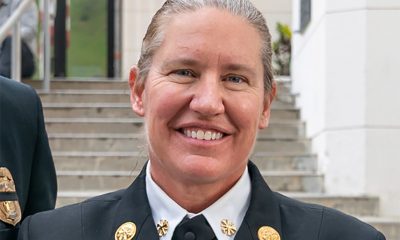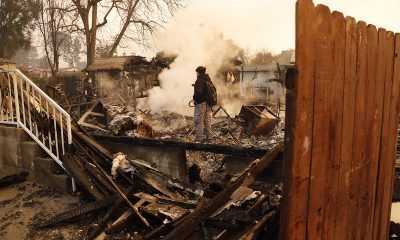Southern California
Triple A: Drivers asked stay alert & drive carefully as kids go back to school
Distracted driving is especially dangerous for pedestrians and bicyclists. Non-drivers account for nearly 1 in 5 distracted driving deaths
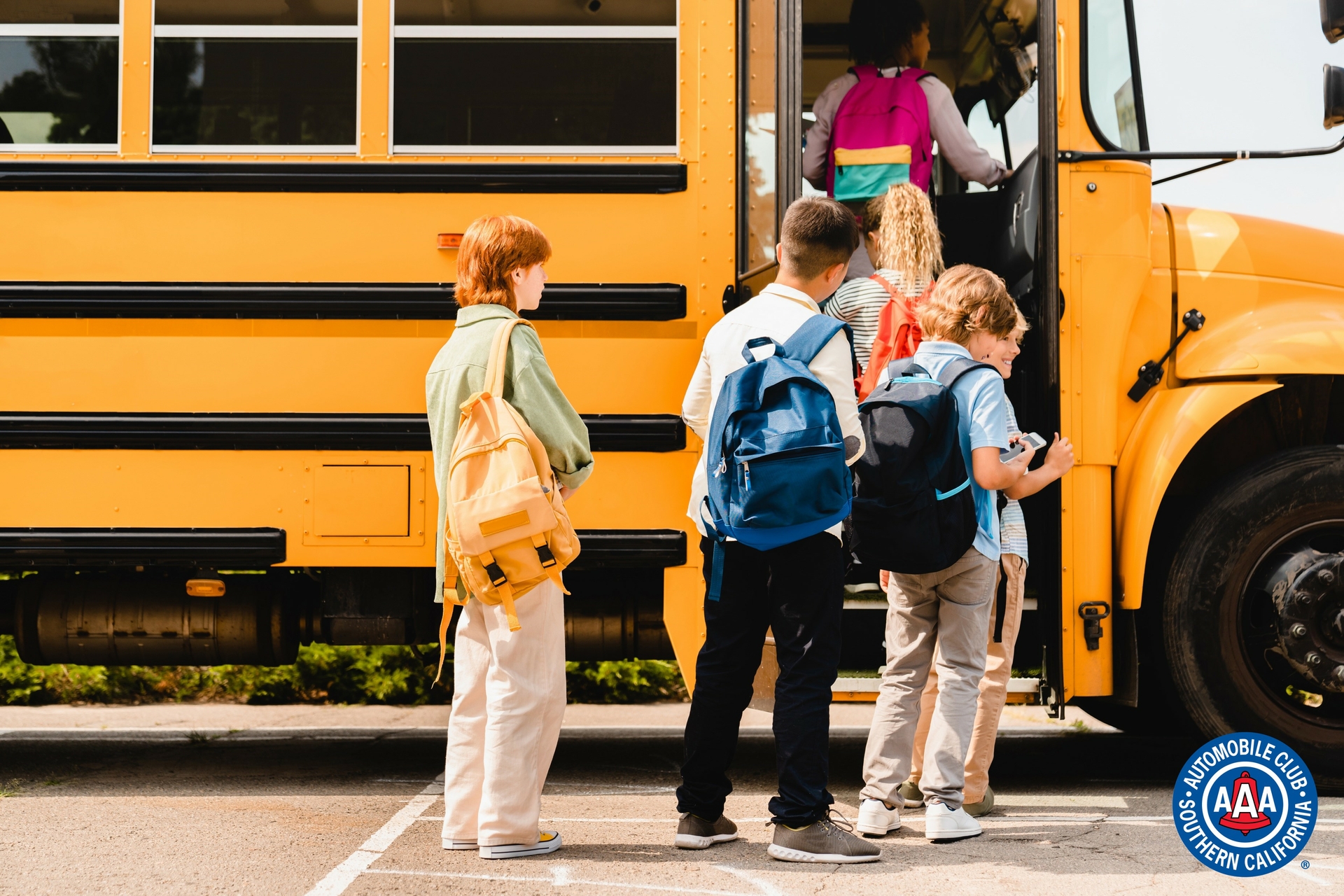
LOS ANGELES – This month Southern California students are returning to classes on foot, bicycles, as well as in cars and school buses. To prevent traffic-related injuries and fatalities to students this school year, the Automobile Club of Southern California reminds drivers to slow down and stay alert in school zones and in other areas where children might be present.
Crashes are the leading cause of death for children and adolescents. The problem escalates during the months kids are in school, and the afternoon school hours are particularly dangerous. Nearly one-third of child pedestrian fatalities occur between 3 p.m. and 7 p.m.
Kids are particularly vulnerable because they are small and less visible to drivers, are not always able to make sound and safe decisions near streets and can be easily distracted when around other kids. Children are not adults, so it is up to drivers to compensate for these differences. AAA’s School’s Open – Drive Carefully! awareness campaign began in 1946 to help reduce child pedestrian fatalities and injuries. Today, this effort is more important than ever due to the prevalence of drivers with smartphones and the increase in distracted driving on our roads.
According to the National Highway Traffic Safety Administration (NHTSA), 3,138 people died in distracted-related crashes in the U.S. in 2020, accounting for 8.1% of all roadway fatalities. That’s an average of 9 people killed each day in crashes that are totally preventable. Additionally, another 400,000 people are injured each year in distracted-related crashes. However, the true numbers of deaths and injuries are likely much higher because distracted driving is often underreported or difficult to determine as the cause of a crash.
Distracted driving is especially dangerous for pedestrians and bicyclists. Non-drivers account for nearly one in five distracted driving deaths. Nationally in 2020, there were 480 pedestrians, 83 bicyclists and 14 other non-occupants killed in crashes that involved a driver who was reported to be distracted. It is unknown how many of these pedestrians, cyclists and other non-occupants were also distracted at the time.
“School-aged children will soon be going to and from campuses, so drivers should prepare for them,” said Auto Club Corporate Communications & Programs Manager Doug Shupe. “If you drive distracted you are “intexticated” behind the wheel, and you could cause the same tragedies as a driver who is impaired by alcohol or drugs. So, make it a habit to put smartphones out of sight and stay alert on the road, especially in school zones, in neighborhoods, around parks, and near bus stops,” said Shupe.
To keep kids safe this school year the Auto Club reminds drivers to:
- Eliminate distractions and put down the cell phone. Children often cross the road unexpectedly and may emerge suddenly between parked cars. Research shows that taking your eyes off the road for just two seconds doubles your chances of crashing.
- Slow down. Speed limits in school zones are reduced for a reason. A pedestrian struck by a vehicle traveling 25 mph is nearly two-thirds less likely to be killed compared to a pedestrian struck by a vehicle traveling just 10 mph faster. A difference between 25 mph and 35 mph can save a life.
- Talk with teens. Car crashes are the leading cause of death for teens in the United States, and more than one-quarter of fatal crashes involving teen drivers occur during after-school hours.
- Come to a complete stop. Research shows that more than one-third of drivers roll through stop signs in school zones or on neighborhood streets. Always come to a complete stop, checking carefully for children on sidewalks and in crosswalks before continuing.
- Watch for bicycles. Children on bikes can be inexperienced, unsteady, and unpredictable. Slow down and allow at least three feet of passing distance between your vehicle and the bicycle. If your child rides a bicycle to school, require that they wear a properly fitted bicycle helmet on every ride.
- Watch for school buses. Yellow flashing lights indicate the bus is preparing to stop to load or unload children. Drivers should slow down and prepare to stop. Red flashing lights and extended stop arms indicate the bus has stopped and children are getting on or off. Drivers MUST stop and wait until the red lights stop flashing, the extended stop-arm withdraws, and the bus begins to move before they can start driving again.
Parents and guardians are also key to keeping children safe during the trip to and from school. Adults should walk with children to familiarize them with the route to school and point out potential traffic hazards.
Students walking to and from school should:
- Wait until you get to your destination before calling people, texting or gaming. If you must text or make a call while walking, stop and find a safe location.
- Avoid using hands-free devices while walking – Hang up and walk!
- Remove your headphones or turn down the volume of your music so you can hear what’s going on around you.
- Watch out for cars while crossing the street. There are a lot of distracted drivers out there so look all around you while in and around crosswalks.
- Be a role model – pay attention while you walk and if you see your friends and family distracted while they walk – speak up.
For more information about the Auto Club’s traffic safety initiative, “Don’t Drive Intoxicated. Don’t Drive Intexticated,” visit aaa.com/dontdrivedistracted to read real stories of lives impacted by distracted driving, watch PSAs, and view a new distracted driving documentary called “Sidetracked.”
Community Services - PSA
LGBTQ+ voter education town hall held tonight in Los Angeles
Unique Women’s Coalition, Equality California and FLUX host discussion on upcoming election.
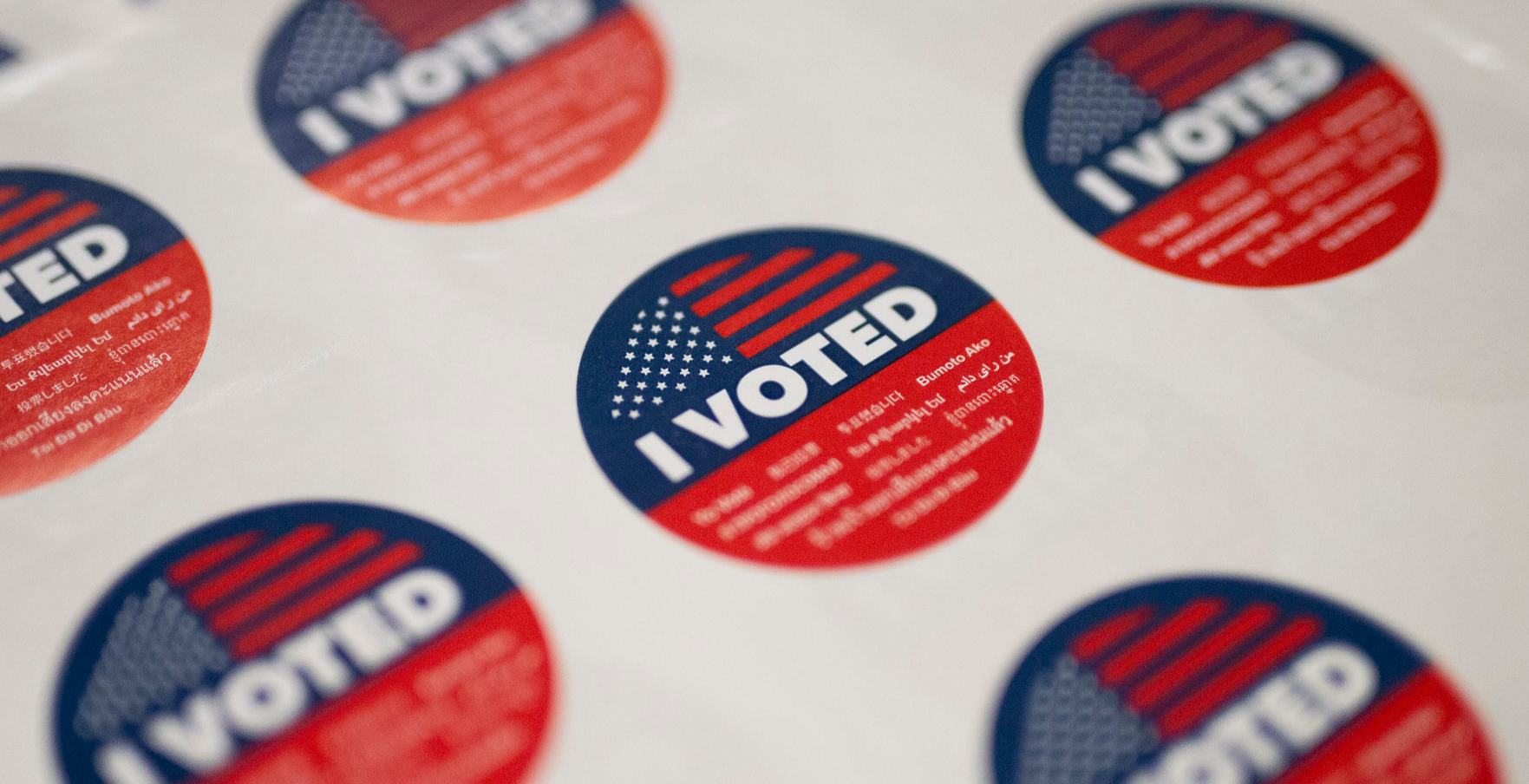
The Unique Women’s Coalition, Equality California and FLUX, a national division of the AIDS Healthcare Foundation, will host their second annual voter education town hall today at the Connie Norman Transgender Empowerment Center in Los Angeles from 7PM to 9PM tonight.
The organizations will present and discuss ballot propositions and measures that will appear on the November ballot and that affect the LGBTQ+ community in this part of the town hall series titled ‘The Issues.’
“The trans and nonbinary community is taking its seat at the table, and we are taking the time and space to be informed and prepare the voter base,” said Queen Victoria Ortega, international president of FLUX.
The town hall will feature conversations through a Q&A followed by a reception for program participants, organizational partners and LGBTQ+ city and county officials.
There will later be a third town hall before the election and The Connie Norman Transgender Empowerment Center will also become a voting location for anyone who feels like they need a safe space to vote, regardless of what voting district they are a part of.
“Our community is really asking for a place to talk about what all of this actually means because although we live in a blue sphere, housing and other forms of discrimination are still a very real threat,” said Scottie Jeanette Madden, director of advocacy at The Connie Norman Transgender Empowerment Center.
Southern California
Triple A: SoCal gas prices continue dropping quickly
The average price for self-serve regular gasoline in California is $4.87, which is 11 cents lower than a week ago
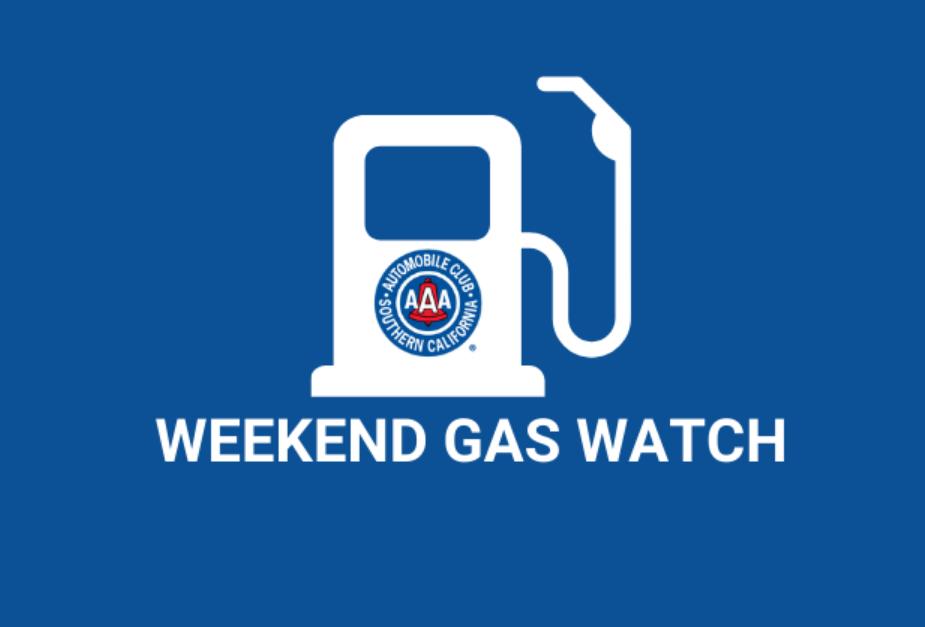
LOS ANGELES – Gas prices in Southern California have dropped by more than 50 cents a gallon in most areas after two straight months of price declines, according to the Auto Club’s Weekend Gas Watch. The average price for self-serve regular gasoline in California is $4.87, which is 11 cents lower than a week ago. The average national price is $3.46, which is two cents lower than a week ago.
The average price of self-serve regular gasoline in the Los Angeles-Long Beach area is $4.83 per gallon, which is 10 cents less than last week and 13 cents less than last year. In San Diego, the average price is $4.85, which is 10 cents lower than last week and eight cents lower than this time last year.
On the Central Coast, the average price is $4.97, which is five cents lower than last week and two cents higher than last year. In Riverside, the average per-gallon price is $4.75, which is 10 cents lower than last week and 10 cents lower than a year ago. In Bakersfield, the $4.96 average price is eight cents less than last week and nine cents higher than a year ago today.
“Oil Price Information Service reports the latest Energy Information Administration data shows that West Coast refinery utilization rates reached their highest production levels of 2024 at the beginning of this month,” said Auto Club Spokesperson Doug Shupe. “California continues to have the highest gas prices in the U.S., but this week for the first time since March, gas prices in most local areas are lower than at this time a year ago.”
The Weekend Gas Watch monitors the average price of gasoline. As of 9 a.m. on June 13, averages are:

Southern California
Triple A: Statewide gas price average drops below $5 a gallon
The average price for self-serve regular gasoline in California is $4.98, which is 11 cents lower than a week ago

LOS ANGELES – The California gas price average dropped below $5 a gallon for the first time since late March, according to the Auto Club’s Weekend Gas Watch. The average price for self-serve regular gasoline in California is $4.98, which is 11 cents lower than a week ago. The average national price is $3.48, which is eight cents lower than a week ago.
The average price of self-serve regular gasoline in the Los Angeles-Long Beach area is $4.93 per gallon, which is 12 cents less than last week and the same price as last year. In San Diego, the average price is $4.95, which is 12 cents lower than last week and six cents higher than this time last year.
On the Central Coast, the average price is $5.02, which is eight cents lower than last week and 12 cents higher than last year. In Riverside, the average per-gallon price is $4.95, which is 11 cents lower than last week and three cents higher than a year ago. In Bakersfield, the $5.04 average price is eight cents less than last week and 17 cents higher than a year ago today.
“According to Oil Price Information Service, Los Angeles wholesale gasoline prices are dropping as large supplies of imported gasoline continue to arrive in Southern California,” said Auto Club Spokesperson Doug Shupe. “A few Southern California gas stations are now charging less than $4.10 a gallon for regular unleaded.”
The Weekend Gas Watch monitors the average price of gasoline. As of 9 a.m. on June 6, averages are:

Southern California
‘Heat dome’ brings scorching conditions but coastal areas spared
The Los Angeles County Health Officer has issued an excessive heat warning as high temperatures have been forecast
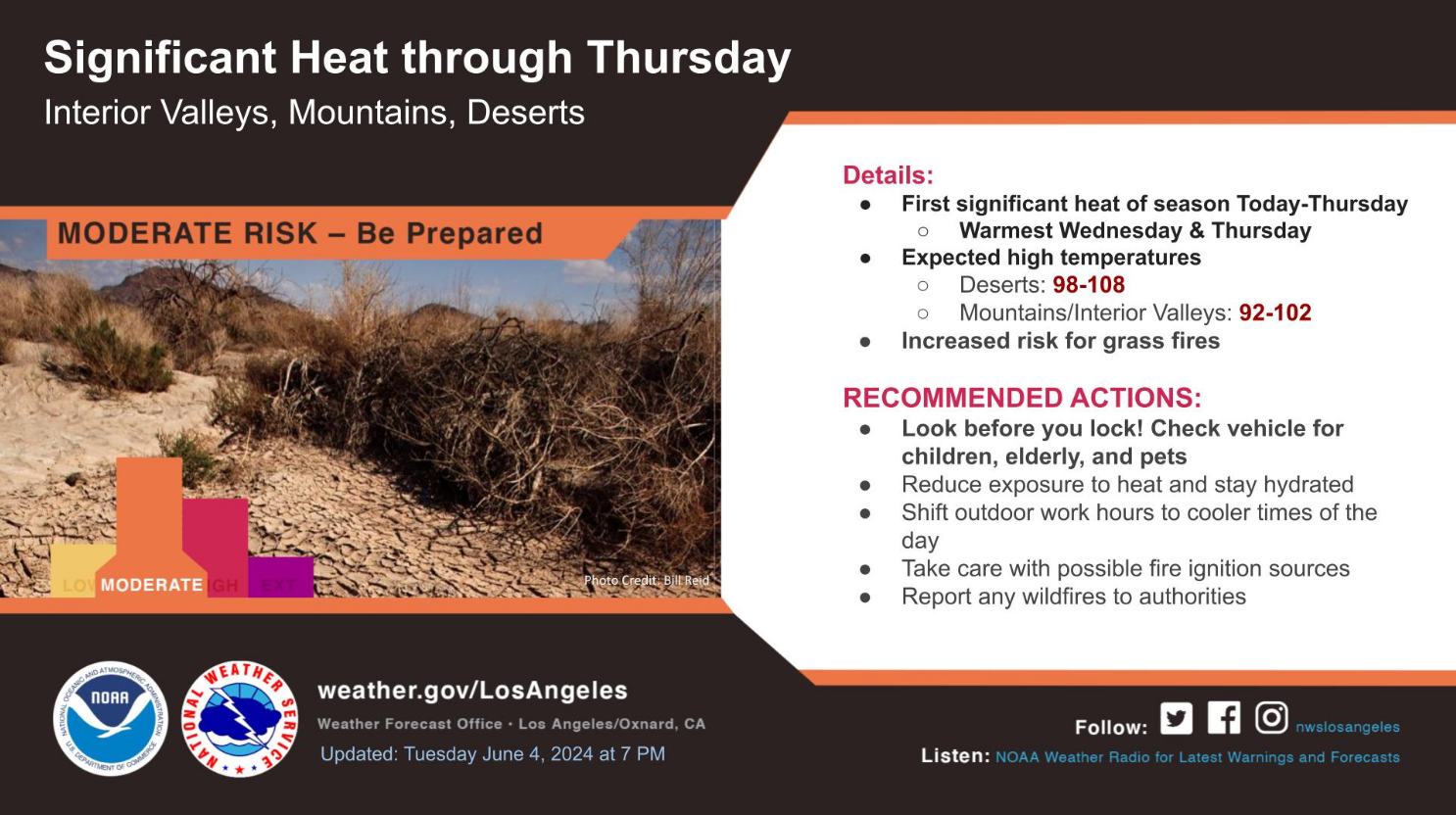
OXNARD, Calif. – The first significant heat of the season has arrived for the interior, and is expected to last into Thursday. Temperatures will be warmest Wednesday and Thursday, with highs in the deserts from 98 to 108, and 92 to 102 for the mountains and interior valleys.
Drier conditions along with breezy conditions will lead to an increased risk for grass fires. Reduce exposure to the heat, and stay hydrated. Look before locking vehicles for children, elderly and pets. Vehicles can become dangerously hot in a short period of time. Report any wildfires to authorities.
High Temperatures Forecast for Parts of Los Angeles County
The Los Angeles County Health Officer has issued an excessive heat warning as high temperatures have been forecast for the following areas:
- Antelope Valley: Wednesday June 05, 2024 through Thursday June 06, 2024
- Western Antelope Valley: Wednesday June 05, 2024 through Thursday June 06, 2024
- Eastern Antelope Valley: Wednesday June 05, 2024 through Thursday June 06, 2024
Public Health reminds everyone to take precautions to avoid heat-related illness, especially older adults, young children, outdoor workers, athletes, and people with a chronic medical condition who are especially sensitive to negative health impacts from extreme heat. Public Health offers the following recommendations during high temperature days:
- Drink plenty of water and keep hydrated throughout the day.
- If you must go out, plan your day to avoid going out during the hottest hours, and wear sunscreen. Wear lightweight, light-colored clothes, and wear a hat or use an umbrella.
- Cars get very hot inside, even if the windows are ‘cracked’ or open. Never leave children or pets in cars. Call 911 if you see a child or pet in a car alone.
- Beware of and know what to do for heat-related illness, such as heat exhaustion and heat stroke. Call 911 right away if you see these symptoms: high body temperature (103°F or higher), vomiting, dizziness, confusion, and hot, red, dry, or damp skin. Heat stroke is a medical emergency.
- Check on those at risk for heat-related illness, like those who are sick or have chronic conditions, older adults, pregnant women, children, those who live alone, pets, and outdoor workers and athletes.
- If you are wearing a mask, avoid strenuous workouts wearing face coverings or masks not intended for athletic purpose
- Visit your power company’s website or contact them by phone to determine if you are scheduled for a rolling power outage.
“On hot days, it’s important for everyone to both take care of themselves and check on others, especially those who have a higher chance of getting ill due to the heat. Some of them include children, the elderly, those with health conditions, pregnant people, those living alone, and pets,” said Muntu Davis, MD, MPH, Los Angeles County Health Officer. “Hot days can be dangerous for anyone, so it’s crucial to stay cool and hydrated. Never leave children, the elderly, or pets alone in hot homes, places, or vehicles. Make sure to check on elderly or unwell neighbors and relatives regularly.”
County and City partners have planned ways to safely operate cooling centers during times of high heat. Residents who do not have access to air conditioning are encouraged to take advantage of these free cooling centers. To find a location near you, visit https://ready.lacounty.gov/heat/ or call 211.
Los Angeles County residents and business owners, including people with disabilities and others with access and functional needs can call 2-1-1 for emergency preparedness information and other referral services. The toll-free 2-1-1 number is available 24 hours a day, seven days a week. 211 LA County services can also be accessed by visiting 211la.org.
Southern California
Triple A: Finally, some SoCal cities drop below $5 a gallon
The average price for self-serve regular gasoline in California is $5.09, which is six cents lower than a week ago

LOS ANGELES – Six straight weeks of price drops at Southern California gas stations have pushed average prices below $5 a gallon in a few cities, according to the Auto Club’s Weekend Gas Watch. The average price for self-serve regular gasoline in California is $5.09, which is six cents lower than a week ago. The average national price is $3.56, which is four cents lower than a week ago.
The average price of self-serve regular gasoline in the Los Angeles-Long Beach area is $5.05 per gallon, which is six cents less than last week and 12 cents higher than last year. In San Diego, the average price is $5.07, which is six cents lower than last week and 17 cents higher than this time last year.
On the Central Coast, the average price is $5.10, which is six cents lower than last week and 21 cents higher than last year. In Riverside, the average per-gallon price is $4.96, which is six cents lower than last week and 13 cents higher than a year ago. In Bakersfield, the $5.12 average price is five cents less than last week and 29 cents higher than a year ago today.
“Oil Price Information Service reports that wholesale Los Angeles gasoline prices are continuing to drop because of increased availability of imported gasoline and reportedly lower levels of demand compared to last year,” said Auto Club Spokesperson Doug Shupe. “Those factors should help pump price drops to continue for now.”
The Weekend Gas Watch monitors the average price of gasoline. As of 9 a.m. on May 30, averages are:

Southern California
Triple A: Memorial Day travelers get a break at the pump
The average price for self-serve regular gasoline in California is $5.15, which is nine cents lower than a week ago

LOS ANGELES – Gas prices continued downward for a fifth straight week, giving some Southern California Memorial Day travelers the chance to fill up for about $4.50 a gallon or even less in a few areas, according to the Auto Club’s Weekend Gas Watch. The average price for self-serve regular gasoline in California is $5.15, which is nine cents lower than a week ago. The average national price is $3.61, which is one cent higher than a week ago.
The average price of self-serve regular gasoline in the Los Angeles-Long Beach area is $5.11 per gallon, which is ten cents less than last week, 27 cents less than last month, and 25 cents higher than last year. In San Diego, the average price is $5.13, which is ten cents lower than last week, 23 cents lower than last month, and 29 cents higher than this time last year.
On the Central Coast, the average price is $5.16, which is five cents lower than last week, 17 cents lower than last month, and 30 cents higher than last year. In Riverside, the average per-gallon price is $5.02, which is ten cents lower than last week, 28 cents lower than last month and 25 cents higher than a year ago. In Bakersfield, the $5.17 average price is five cents less than last week, 15 cents less than last month, and 36 cents higher than a year ago today.
“With an all-time record number of Southern California travelers expected for this Memorial Day getaway weekend, the gas price drops are providing some welcome relief,” said Auto Club Spokesperson Doug Shupe. “Those travelers who are planning out-of-state trips should expect to pay even less when they fuel up for their return, since California continues to be the only U.S. state with a gas price average above $5 a gallon.”
The Weekend Gas Watch monitors the average price of gasoline. As of 9 a.m. on May 23, averages are:

Southern California
Triple A: Gas prices drop for four straight weeks
The average price for self-serve regular gasoline in California is $5.24, which is eight cents lower than a week ago

LOS ANGELES – Local gas prices have dropped for four straight weeks, but California continues to be the only state with an average price above $5 a gallon, according to the Auto Club’s Weekend Gas Watch. The average price for self-serve regular gasoline in California is $5.24, which is eight cents lower than a week ago. The average national price is $3.60, which is four cents lower than a week ago.
The average price of self-serve regular gasoline in the Los Angeles-Long Beach area is $5.21 per gallon, which is eight cents less than last week, 18 cents less than last month, and 37 cents higher than last year. In San Diego, the average price is $5.23, which is six cents lower than last week, 14 cents lower than last month, and 41 cents higher than this time last year.
On the Central Coast, the average price is $5.22, which is five cents lower than last week, 14 cents lower than last month, and 38 cents higher than last year. In Riverside, the average per-gallon price is $5.12, which is eight cents lower than last week, 19 cents lower than last month and 36 cents higher than a year ago. In Bakersfield, the $5.23 average price is three cents less than last week, eight cents less than last month, and 40 cents higher than a year ago today.
“California continues to have the highest average gas prices in the U.S., and despite a month of price declines, the state average price is still more than 40 cents higher than Hawaii, which is the second most expensive state for fuel,” said Auto Club Spokesperson Doug Shupe.
The Weekend Gas Watch monitors the average price of gasoline. As of 9 a.m. on May 16, averages are:

Southern California
Triple A: Gas prices head down for third straight week
The average price for self-serve regular gasoline in California is $5.32, which is six cents lower than a week ago

LOS ANGELES – Southern California gas prices have dropped for the third straight week, according to the Auto Club’s Weekend Gas Watch. The average price for self-serve regular gasoline in California is $5.32, which is six cents lower than a week ago. The average national price is $3.64, which is three cents lower than a week ago.
The average price of self-serve regular gasoline in the Los Angeles-Long Beach area is $5.28 per gallon, which is six cents less than last week, six cents less than last month, and 42 cents higher than last year. In San Diego, the average price is $5.29, which is five cents lower than last week, five cents lower than last month, and 44 cents higher than this time last year.
On the Central Coast, the average price is $5.27, which is six cents lower than last week, two cents lower than last month, and 41 cents higher than last year. In Riverside, the average per-gallon price is $5.20, which is seven cents lower than last week, five cents lower than last month and 43 cents higher than a year ago. In Bakersfield, the $5.26 average price is four cents less than last week, five cents more than last month, and 42 cents higher than a year ago today.
“According to Oil Price Information Service (OPIS), California and all West Coast refineries are continuing to operate at higher capacities and West Coast gasoline inventories are increasing in anticipation of higher summer demand,” said Auto Club Spokesperson Doug Shupe.
The Weekend Gas Watch monitors the average price of gasoline. As of 9 a.m. on May 9, averages are:

Southern California
Triple A: SoCal gas prices continue downward
The average price for self-serve regular gasoline in California is $5.38, which is three cents lower than a week ago

LOS ANGELES – Southern California gas prices are continuing to drop for a second straight week, according to the Auto Club’s Weekend Gas Watch. The average price for self-serve regular gasoline in California is $5.38, which is three cents lower than a week ago. The average national price is $3.67, which is one cent higher than a week ago.
The average price of self-serve regular gasoline in the Los Angeles-Long Beach area is $5.34 per gallon, which is three cents less than last week, 18 cents higher than last month, and 44 cents higher than last year. In San Diego, the average price is $5.34, which is two cents lower than last week, 19 cents higher than last month, and 45 cents higher than this time last year.
On the Central Coast, the average price is $5.33, which is the same as last week, 22 cents higher than last month, and 45 cents higher than last year. In Riverside, the average per-gallon price is $5.27, which is two cents lower than last week, 21 cents higher than last month and 45 cents higher than a year ago. In Bakersfield, the $5.30 average price is one cent less than last week, 29 cents more than last month, and 44 cents higher than a year ago today.
“After a few months of supply interruptions from refinery breakdowns and maintenance, Oil Price Information Service (OPIS) reports that California refineries have been operating at above 86% of their capacity for the past two weeks,” said Auto Club Spokesperson Doug Shupe. “Additionally, OPIS reported the US Energy Information Administration believes that the country has already experienced its highest gas price point for the first half of this year. Although California prices often go against national trends, that prediction is an encouraging sign for further price drops at the pump.”
The Weekend Gas Watch monitors the average price of gasoline. As of 9 a.m. on May 2, averages are:

Southern California
Triple A: Southern California gas prices begin to slowly decrease
The average price for self-serve regular gasoline in California is $5.41, which is four cents lower than a week ago

LOS ANGELES – Southern California gas prices slightly decrease in almost every metro city, according to the Auto Club’s Weekend Gas Watch. The average price for self-serve regular gasoline in California is $5.41, which is four cents lower than a week ago. The average national price is $3.66, which is also one cent higher than a week ago.
The average price of self-serve regular gasoline in the Los Angeles-Long Beach area is $5.37 per gallon, which is two cents less than last week, 33 cents higher than last month, and 44 cents higher than last year. In San Diego, the average price is $5.36, which is two cents lower than last week, 34 cents higher than last month, and 45 cents higher than this time last year.
On the Central Coast, the average price is $5.33, which is two cents lower than last week, 31 cents higher than last month, and 43 cents higher than last year. In Riverside, the average per-gallon price is $5.29, which is three cents lower than last week, 37 cents higher than last month, and 45 cents higher than a year ago. In Bakersfield, the $5.31 average price is the same as last week, 40 cents more than last month, and 43 cents higher than a year ago today.
“For the first time in almost two months prices in Southern California have slightly decreased,” said Auto Club Spokesperson Doug Shupe. “The reasons for gas prices moving lower include slowing domestic gasoline demand between Spring Break and summer travel, as well as the cost of crude oil retreating.”
The Weekend Gas Watch monitors the average price of gasoline. As of 9 a.m. on April 25, averages are:
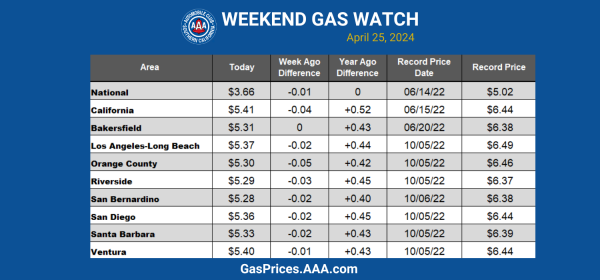
-
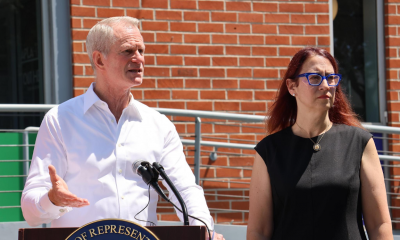
 Breaking News1 day ago
Breaking News1 day agoMajor victory for LGBTQ funding in LA County
-

 Features1 day ago
Features1 day agoKoaty & Sumner: Finding love in the adult industry
-

 a&e features4 days ago
a&e features4 days agoLatina Turner comes to Bring It To Brunch
-

 Books3 days ago
Books3 days agoTwo new books on dining out LGBTQ-style
-

 Television5 days ago
Television5 days ago‘White Lotus,’ ‘Severance,’ ‘Andor’ lead Dorian TV Awards noms
-
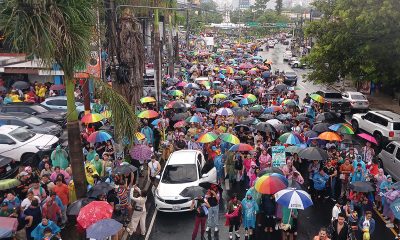
 El Salvador1 day ago
El Salvador1 day agoLa marcha LGBTQ+ desafía el silencio en El Salvador
-

 Miscellaneous11 hours ago
Miscellaneous11 hours agoCan you really find true love in LA? Insights from a queer matchmaker
-

 Arts & Entertainment12 hours ago
Arts & Entertainment12 hours agoIntuitive Shana gives us her hot take for July’s tarot reading



